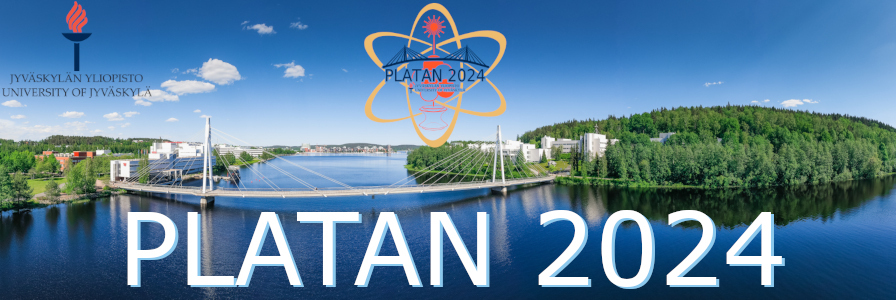Thorben Niemeyer
(Johannes Gutenberg University Mainz)
Radionuclide metrology techniques, as currently used for activity standardization, show a large variety of measurement uncertainties – from permille accuracy, e.g., for the α-decaying isotope Am-241 (T1/2 = 432 a) up to few percent for Fe-55 (T1/2 = 2.73 a), which decays by electron capture. To reduce such uncertainties, a new standardization technique using direct ion beam implantation of the pure radionuclide into metallic microcalorimeters (MMCs) is explored within the European project PrimA-LTD. The intrinsically high energy resolution of such devices additionally allows for determination of electron capture probabilities with unprecedented accuracy, in this way enables the improvement of theoretical models and correspondingly has a broad impact on radionuclide metrology, nuclear power industry, nuclear medicine and radiopharmacy.
The implantation of 5 Bq of Fe-55 into each minuscule absorber, sized 0.14 x 0.14 mm2, of such MMC detectors was performed at the RISIKO mass separator at Mainz university using resonance ionization mass separation and specific focalization and automated pointing. The technique was chosen due to its outstanding element selectivity and overall implantation efficiency guaranteeing the required implantation purity. A novel two-step ionization scheme for iron was identified and characterized in stable Fe-56, implying efficient second and third harmonic generation of the Ti:Sa laser radiation used at RISIKO. One of different strong auto-ionizing states was used for implantation of the Fe-55. In Fe-56, the analysis of a long series of Rydberg states allows to verify the ionization potential and extend the existing data on even parity Rydberg states in Fe. The spectroscopic results will be discussed as prerequisite for the implantation process.
The project has received funding from the EMPIR program 20FUN04 PrimA-LTD from the European Union's Horizon 2020 research and innovation program.
Thorben Niemeyer
(Johannes Gutenberg University Mainz)
Christoph Düllmann
(Department Chemie - Standort TRIGA, Johannes Gutenberg - Universit ̈at Mainz, Germany; GSI Helmholtzzentrum f ̈ur Schwerionenforschung, Darmstadt, Germany; Helmoltz Institute Mainz, Mainz, Germany)
Christoph Mokry
(Johannes Gutenberg Universität Mainz - Department of chemistry, TRIGA Standort, 55099 Mainz, Germany; Helmholtz-Institut Mainz, 55099 Mainz, Germany)
Mr
Daniel Mowitz
(Johannes Gutenberg University Mainz)
Dr
Dennis Renisch
(Johannes Gutenberg University Mainz, Deparment of chemistry - TRIGA Standort; Helmholtz-Institut, Mainz)
Dominik Studer
(Helmholtz-Institut Mainz, 55099 Mainz, Germany; GSI Helmholzzentrum für Schwerionenforschung GmbH, 64291 Darmstadt, Germany)
Holger Dorrer
(Johannes Gutenberg Universität Mainz, Deparment of chemistry, TRIGA Standort,55099 Mainz, Germany)
Prof.
Jung Bog Kim
(Korea National University of Education)
Jörg Runke
(Johannes Gutenberg Universität Mainz, 55099 Mainz, Germany; GSI Helmholzzentrum für Schwerionenforschung GmbH, 64291 Darmstadt, Germany)
Jörn Beyer
(Physikalisch-Technische Bundesanstalt)
Prof.
Klaus Wendt
(Johannes Gutenberg University Mainz, Institute of Physics)
Mr
Michael Müller
(Institute of Micro- and Nanoelectronic Systems (IMS), Karlsruhe Institute of Technology (KIT))
Dr
Nina Kneip
(Johannes Gutenberg University Mainz, Institute of Physics)
Dr
Ole Nähle
(Physikalisch-Technische Bundesanstalt (PTB), Bundesallee 100, 38116, Braunschweig)
Raphael Hasse
(Johannes Gutenberg University Mainz, Institute of Physics)
Mr
Sebastian Berndt
(Johannes Gutenberg University Mainz, Institute of Physics; Johannes-Gutenberg University, Department of Chemistry, TRIGA Standort)
Prof.
Sebastian Kempf
(Institute of Micro- and Nanoelectronic Systems, Karlsruhe Institute of Technology; Institut for Data Processing and Electronics (IPE), Karlsruhe Institute of Technology)
Tom Kieck
(GSI Helmholtzzentrum für Schwerionenforschung GmbH; Helmholtz Institute Mainz)
There are no materials yet.

